|
Forums36
Topics40,962
Posts557,968
Members18,502
| |
Most Online3,612
Jan 10th, 2023
|
|
|
8 members (Donatello, Sunil, Rick O, canyoncreek, catscratch, Shorthose, Theo Gallus, KenHorton),
1,140
guests, and
284
robots. |
|
Key:
Admin,
Global Mod,
Mod
|
|
|
|
Joined: Jun 2009
Posts: 13
Lunker
|

Lunker
Joined: Jun 2009
Posts: 13 |
GW I will take some pics and post tomorrow. I see in your pics I do not have the amount of larve needed to be near full capacity. I do have a lot but it still have a lot of room to grow. I do have egg clusters that are due to hatch.
|
|
|
|
|
Joined: Apr 2007
Posts: 2,287
Lunker
|
OP

Lunker
Joined: Apr 2007
Posts: 2,287 |
Randy, thanks for reinforcing that you don't need a huge colony to repel houseflies. I edited my previous post to be more clear. 267, my best guess at this point is that you have too many food scraps for the size of your colony. If food is going uneaten for days and days then you probably should stop feeding for a while and let the colony expand enough to catch up. If your egg clusters are from the wild BSF population your colony is ready to bloom. If the eggs are from a starter kit then you may need a little more patience until the wild BSF find your unit. Whatever you do don't use any grubs as feed until you have established the breeding cycle. Until you're getting almost constant reproduction I recommend protecting all mature BSF grubs to the point where they emerge from their pupae. After that they're on their own. Being in Texas I can't imagine that you won't have a robust colony going very soon. I know someone culturing BSF on an 8th floor balcony in Dallas. 
|
|
|
|
|
Joined: Jun 2009
Posts: 13
Lunker
|

Lunker
Joined: Jun 2009
Posts: 13 |
ok sounds good I will stop using the grubs as feed. do I just leave them in the collection bucket or do I need to put them in a separate bucket of some sort. The eggs I have are from wild population. So I definitely think I will have a bloom soon for sure. I was feeding them to the chickens. I guess I was jumping the gun a little.
|
|
|
|
|
Joined: Apr 2007
Posts: 2,287
Lunker
|
OP

Lunker
Joined: Apr 2007
Posts: 2,287 |
If you have wild BSF laying eggs in your BioPod you really don't have to worry about saving mature grubs. Still, if you want a larger colony sooner, then saving some will speed up the process.
Whatever you do it's not advisable to leave the grubs in the collection bucket to pupate because they usually can't find their way out when they emerge as adults. I save some mature grubs because I send them to people as part of a starter kit. Sometimes I end up with pupated grubs and I keep them in buckets with about an inch of sawdust. You need to keep them out of the sun and the rain if you do this. You can put a lid on them, but they must have vent holes which also gives them a way to escape.
|
|
|
|
|
Joined: Jun 2009
Posts: 13
Lunker
|

Lunker
Joined: Jun 2009
Posts: 13 |
|
|
|
|
|
Joined: Mar 2004
Posts: 2,435
Ambassador Hall of Fame 2014  Lunker
|

Ambassador Hall of Fame 2014  Lunker
Joined: Mar 2004
Posts: 2,435 |
Just do it...
|
|
|
|
|
Joined: Apr 2007
Posts: 2,287
Lunker
|
OP

Lunker
Joined: Apr 2007
Posts: 2,287 |
267, as you said, it looks like a lot of fruit fly larvae and maybe other fly species mixed in with your BSF. What I don't see is small and medium size BSF larvae. I also think your photos confirm what I thought about the amount of food in your unit. I would stop adding any food scraps at all until you see new BSF hatching out.
Thanks for sharing the photos. Do you happen to have any of the eggs you believe to be from BSF?
|
|
|
|
|
Joined: Jun 2009
Posts: 13
Lunker
|

Lunker
Joined: Jun 2009
Posts: 13 |
ooh I totally forgot to take the pictures of the new BSF eggs. I will do so tomorrow and Post them. How long does it take to hatch thier eggs again? I noticed eggs are light when layed then turn to a darker color.. yellowish. Its been really hot here 100 and up. but the unit is in the shade. I don't know if I am ancious the eggs are not hatching because I dont see any baby BSF. Should I keep the lid off to help attract more BSF females.
Last edited by 267; 07/09/09 01:55 AM.
|
|
|
|
|
Joined: Apr 2007
Posts: 2,287
Lunker
|
OP

Lunker
Joined: Apr 2007
Posts: 2,287 |
The colors you're describing follow the same pattern as BSF eggs which they most likely are. It takes about 4 days for them to hatch. I would guess that you've already had some hatch but the new grubs are still so tiny that they can't be seen in your photos above. I'm pretty sure that within a week or two you'll be seeing thousands of new BSF grubs. Here's a photo that shows the color variations of BSF eggs as they age: 
|
|
|
|
|
Joined: Feb 2009
Posts: 5
Fingerling
|

Fingerling
Joined: Feb 2009
Posts: 5 |
Absolutely, i am very intereting in the Biopod. However, as we known, the adult black soldier flies are sensitive to sunlights,which can stimulate them mating, and the flies mating completes in the sky, so how does the Biopod do this?
By the way, resently the black soldier fly blog of you can not be open, i want to get more information about the black soldier fly, would you please send me one through e-mail? thanks! pinglei161@yahoo.cn
|
|
|
|
|
Joined: Apr 2007
Posts: 2,287
Lunker
|
OP

Lunker
Joined: Apr 2007
Posts: 2,287 |
P.Tony, the BioPod is not a closed system meaning that pupation and mating happen outside.
My blog seems to be working so I hope that you will be able to open it in the future.
|
|
|
|
|
Joined: Feb 2009
Posts: 5
Fingerling
|

Fingerling
Joined: Feb 2009
Posts: 5 |
Dear GW, i tried to open it but failed again and again. it is so kind of you to send the WORD version to me.
|
|
|
|
|
Joined: Jun 2009
Posts: 13
Lunker
|

Lunker
Joined: Jun 2009
Posts: 13 |
GW I know I had a lot of eggs laid in the dome. Like I said they turned brown. But I am really starting to think heat will kill the eggs. My larve count has gone down. I think it was dute to the extreme heat we had here for about 3 weeks straight. Triple digits everyday. What do you think. I saved all the grubs and let them do their thing about a months worth of grubs and still the bucket does not look like yours.
|
|
|
|
|
Joined: Apr 2007
Posts: 2,287
Lunker
|
OP

Lunker
Joined: Apr 2007
Posts: 2,287 |
267, it took me more than two months to establish such a healthy colony on a property that has had maybe more than 100,000 mature BSF grubs released on it over a two year period. It takes a little patience, but in Texas it should just be a matter of time before you succeed. The fact that you did see a lot of BSF eggs in your BioPod indicates you have a breeding population on your property. I doubt that hot weather will kill the eggs but a lack of humidity will. Having said that, I also doubt that there is a lack of humidity in your unit because of the melon and other food scraps. How closely have you studied the waste for signs of smaller BSF grubs? You might want to try turning over a few pieces of food scraps to see if smaller BSF might be present. Hot weather will definitely be an issue when your colony starts to become dense with grubs. A dense colony with a lot of available food generates significant heat. On especially hot or windless days I add a few wood spacers between the BioPod lid and body. I think it significantly increases ventilation. You can also simply remove the lid but I wouldn't recommend doing that overnight. I do often leave the spacers in place overnight and I haven't had an problems from raccoons yet. If you remove the lid be careful where you set it because ants will raid the eggs in the egg disc. (click to enlarge) 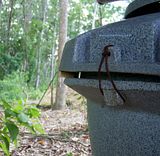 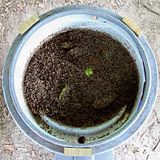

|
|
|
|
|
Joined: Jun 2009
Posts: 13
Lunker
|

Lunker
Joined: Jun 2009
Posts: 13 |
are your grubs always swarming? there are some on the unter all the brown stuff. If I dig I will find them. They only come out when there is food. I still have a lot of house fly larve. Food consumption is happening and I am still getting mature grubs so I am doing something right. I have been putting the mature ones in a bucket with sawdust. It rained a couple days ago and the sawdust got damp/ wet. I checked on it today and seems none of the larve are moving and have shrunk to the size of a tic tac. should I keep them in somehting different. do you think they died?
|
|
|
|
|
Joined: Apr 2007
Posts: 2,287
Lunker
|
OP

Lunker
Joined: Apr 2007
Posts: 2,287 |
The BSF grubs will only be on the top of the pile if there is food there. If I don't feed them for a day or two almost all of them will go below the surface in search of food.
The size of the mature grubs and can vary quite a bit and I've seen many pupae that were 1/2 inch long or maybe even a little less. Of course all of the mature grubs will stop moving after they pupate and most likely you'll start to see the adult BSF emerging in several days. I'm recommending only about an inch of sawdust because if it's too deep it can be hard for the newly emerged adult BSF to climb out.
I'm looking forward to hearing that you have small BSF grubs in your BioPod. After that your colony should expand quickly.
Thanks for the photos and the updates 267.
|
|
|
|
|
Joined: Jun 2009
Posts: 13
Lunker
|

Lunker
Joined: Jun 2009
Posts: 13 |
Well it got down to the 90's and rained for about 3 days straight. I checked the bin yesterday and The population explosion of grubs has happened. There is also an explosion of eggs in the lid. about 20 holes were filled with eggs. It is getting better and better everyday. I have been giving them a cup of dog food everyday. also recycling 100% of the grubs. I can some times see 3 adult fly's at the same time. I am
|
|
|
|
|
Joined: Apr 2007
Posts: 2,287
Lunker
|
OP

Lunker
Joined: Apr 2007
Posts: 2,287 |
Someone should check on 267, it seems that he was abducted while typing that last post.  267, you might think about installing the ventilation shims I mentioned a few posts above. Very soon you're going to have a biological engine running at high rpm's and you'll be dealing the resulting heat. You'll probably see times when large numbers of juvenile grubs migrate out of the main body of the BioPod and into the collection bucket. That's usually because they're trying to escape excessive heat. When that happens you can either remove them (I often feed them to my fish), or you can put them back into the unit when it cools off. Leaving the lid off can also help keep things cooler. I recently went out of town for 8 days and up to that time my colony was at maximum. I didn't want my girlfriend to have to deal the constant stream of mature grubs that I was expecting so I removed a large number of juvenile grubs. This resulted in greatly reducing the activity (and heat) in the colony and when I got back there were only a few grubs in the collection bucket. That experience made me realize that removing juvenile grubs could be a great management tool, especially for BSF colonies in hot climates with large populations of wild BSF. To remove the juvenile grubs I used the method described HERE, only I used a larger container. The series of photos below shows one of three batches of grubs that I removed that weighed 8 lbs in total. The level inside of my BioPod was lowered at least two inches. My fish ate well that day.  (click images to enlarge) 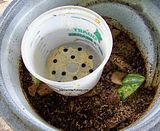 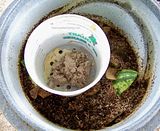 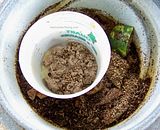  

|
|
|
|
|
Joined: Aug 2009
Posts: 14
Lunker
|

Lunker
Joined: Aug 2009
Posts: 14 |
I noticed that the eyeball wasn't gotten into. I wonder why?
I've been reading this blog intently for about a week. I stumbled on to bsfl a few months ago while going through my manure/compost/red wriggler beds.
At first, like some other folks, I got rid of them thinking they would be bad for my worms. Once I found out what they were, it has been nonstop feeding and learning. It seems I am going through all the same hard knocks as you and others. My latest lesson was this:
I cleaned ten rabbits about 4 lbs each the day before we went out of state to see my parents for 5 days. Evening before we left, I put all ten rabbits's internals (stomaches full of rabbit food too) into my Larvae bin. When we got back home I had to look inside first thing. All the internals were 95%? gone, but I had alot of premature crawloff and lots of larvae drowned due to high temps. and too much moisture content. Yesterday morning early, I put in a quart bag of catfish fillets that were freezer burnt, 10 rabbit livers and hearts. Today I put a half cup of Lousiana Fish Fry on top of that. Some used coffee grounds and two tomatoes also. I will have to add high starch/Dry Items for a week or so now to get the population back up. Something that I found by accident when making my worm/larvae bin was I had drilled 1/64" holes in the top, sides, and bottom for air and drainage for a worm bin. What happened then was the BSF laid her eggs just outside the small holes and the larvae found their way in and the regular flies couldn't get in to regurgitate sp? their maggot eggs and so this particular worm bin went from worms and pods to a co'existing situation to a thriving larvae bin to a too hot, too much moisture, and premature crawloff. I did have a few good hand fulls of Larvae in my container though. Some of them were not quite ready to migrate and were about 1/2" long. They went into the freezer with the others. Always learning and hope you can add to this! Thanks for starting this Blog. Bill
|
|
|
|
|
Joined: Apr 2007
Posts: 2,287
Lunker
|
OP

Lunker
Joined: Apr 2007
Posts: 2,287 |
Hi Bill, I'm glad you've been enjoying your black soldier fly grubs. I noticed that the eyeball wasn't gotten into. I wonder why? You must be referring to a photo of BSF consuming a fish. Rest assured that by the next day there won't be anything left but scales and bones. From what I understand fish bones will also be eaten in time, but not mammal bones. BSF have difficulty getting through even very thin membranes which is why they can't really target fresh food. A tomato with unbroken skin probably won't get eaten by BSF grubs, but put one tiny hole in it and that tomato will be gone in an hour. The only thing left uneaten would be the paper-thin skin and any woody stuff like the stem. All the internals were 95%? gone, but I had alot of premature crawloff and lots of larvae drowned due to high temps. and too much moisture content. Draining off the liquids is one of the biggest challenges in setting up a BSF unit. Accumulated liquids can lead to problems because the grubs can't effectively aerate waste that's flooded and this can result in anaerobic (no oxygen) conditions. This in turn causes bad odors and invites risky strains of bacteria. The relatively small drain on a BioPod tends to get clogged so now the manufacturer is recommending a layer of coir (fiber from coconut husks used in wire hanging baskets). The coir works like a pre filter it's biodegradable. Keeping the colony cool is important. Keeping it in full shade is a good start, but on very hot days it's a good idea to go "topless" if the unit is protected from rain (and dogs). In general, the more ventilation, the better. Yesterday morning early, I put in a quart bag of catfish fillets that were freezer burnt, 10 rabbit livers and hearts. Today I put a half cup of Lousiana Fish Fry on top of that. Some used coffee grounds and two tomatoes also. Sounds like one of my girlfriend's recipes!  Thanks Bill, please keep us updated on your progress. (I was only kidding sweetheart, your cooking is the best.  )

|
|
|
|
|
Joined: Aug 2009
Posts: 14
Lunker
|

Lunker
Joined: Aug 2009
Posts: 14 |
Just recently, I ran across a chart on the internet that shows the hardiness zones for BSF. Can't find it now, but it is out there.
|
|
|
|
|
Joined: Apr 2007
Posts: 2,287
Lunker
|
OP

Lunker
Joined: Apr 2007
Posts: 2,287 |
BSFfanatic, you probably saw a post on my blog where I used the USDA hardiness zone map as a guideline for black soldier fly populations. Here are some quotes from that page which put the usefulness of the map into perspective: In general the warmer and wetter your climate, the more likely it is that you already have black soldier flies in your area. Colder and drier climates represent less likely places to find BSF and they are the most challenging places to establish a colony. This is also true of elevations over 5000 feet (1500m). The native range of BSF is the southeastern U.S. but over time they have been transported around the world.
BSF are most commonly found in the USDA plant hardiness zones 7 - 10, but there are often exceptions. The hardiness zones relate to temperature only and while this is the most important factor with BSF it isn't the only one. I've gotten reports of robust BSF populations in zone 6 and I wouldn't be surprised to hear of them in cooler zones in the future. I've also published the same information as a sort of disclaimer to potential BioPod customers: The BioPod™ is not an appliance. By that I mean you can’t simply buy one, add food waste to it without further involvement and expect it to perform properly. Successful operation of a BioPod requires regular observation of the black soldier fly (BSF) colony and small adjustments designed to keep it balanced. There are only a few simple adjustments involved, but to know which to use you will need to learn about BSF. It’s similar in scope to learning how to ride a bicycle and about as easy. and... Please do some research before you buy. Your geographic location and even the altitude at which you live will effect how easy or difficult it is to culture black soldier flies (Hermetia illucens). Culturing BSF is possible anywhere, but if you live along the west coast or in the southeastern U.S. there’s a very good chance BSF are already around you and starting a colony will be relatively easy. If you live in a cold or dry climate the difficulty level increases. If you’re not sure about your specific area please contact us and we’ll do our best to inform you. and... The key to making it simple is to study the black soldier fly grubs and to understand how various factors effect them. If you don’t learn the basic behaviors and needs of these fascinating animals then you will probably have difficulty keeping them. If you learn to avoid overfeeding and overheating the colony you’ll be most of the way there. I enjoy it when someone buys a BioPod from me, but I want them to understand what they're getting. If you want to keep BSF you'll need to learn about them so it makes sense to start the learning process before you spend any money. I'm also working on a DIY "bucket o' bugs" BSF unit for people who want to try establishing a colony inexpensively before committing to a BioPod. It's based on a common 5 gallon bucket, a few other cheap materials, and about 15 minutes of labor. Maintaining a colony in the bucket will be time consuming and relatively inefficient, but it's designed to be an introduction and from there a person can decide if they want to craft something more elaborate or purchase a BioPod.

|
|
|
|
|
Joined: Aug 2009
Posts: 14
Lunker
|

Lunker
Joined: Aug 2009
Posts: 14 |
GW, I would like to know what I can feed my composting worms so that the BSF won't lay eggs in their bedding.
Ever since I started with my red wriggler worms it has been a constant BSF population in all 4 containers. I am sure some people out there would be happy to be in my situation, However, I want to keep my composting worms separate from the Larvae until I figure out how to separate the fertile soil from the Larvae to use for future worm bedding.
Manure worms are supposed to get bigger, fatter, and more lively if their diet is manure. All I have to use is rabbit, chicken and hog "waste", but every time I put some hog manure in on top of my worms, I end up getting more Larvae. I know that they can coexist, but I don't want to find out how many BSFL it takes in a container of worms, to kill my worms.
I am thinking that if I switch to putting cellulose and cardboard on the worms and continue with food scraps, high starch, animal feed, etc on the Larvae, hopefully the BSF will not even look at the worm containers.
Then I am assuming that after so long with just grass clippings, water, and cardboard, all the BSf sould cycle out?
|
|
|
|
|
Joined: Aug 2009
Posts: 14
Lunker
|

Lunker
Joined: Aug 2009
Posts: 14 |
mrgrackle, What kind of worms do you have in that blue barrel?
Do you feed them different food than the Larvae?
Does your plywood fit the top of the blue barrel so that BSF can't get in?
I have Larvae in all my worm bins and it doesn't stop. I have really enjoyed reading all the different posts on this blog too. I appreciate your input as I am trying to figure out how to raise red wrigglers and BSFL separately.
|
|
|
|
|
Joined: Apr 2007
Posts: 2,287
Lunker
|
OP

Lunker
Joined: Apr 2007
Posts: 2,287 |
I am thinking that if I switch to putting cellulose and cardboard on the worms and continue with food scraps, high starch, animal feed, etc on the Larvae, hopefully the BSF will not even look at the worm containers.
Then I am assuming that after so long with just grass clippings, water, and cardboard, all the BSf sould cycle out? Nothing wrong with that logic. Your idea is the most effective approach. Alternatively you could keep the worm bins in a screened area that wouldn't allow the adult BSF females access. Even then a few might get in if you weren't careful. Putting screen directly over the bin itself won't help because the BSF will just lay eggs on the screen and the tiny grubs will fall or crawl into the bin. To be honest you may have the same problem if you use the BSF castings for worm bedding. I'm afraid the castings will also serve to attract BSF to your worm bin. In fact I'm counting on it because I include castings in my BSF starter kits for just that reason. I inadvertently discovered a biological BSF deterrent but I'm not sure that it's 100% effective: 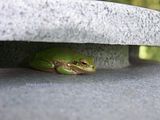  mrgrackle, What kind of worms do you have in that blue barrel? We haven't heard from mrgrackle for several months, but I believe he was using traditional composting techniques without the addition of worms.

|
|
|
Moderated by Bill Cody, Bruce Condello, catmandoo, Chris Steelman, Dave Davidson1, esshup, ewest, FireIsHot, Omaha, Sunil, teehjaeh57 |
|